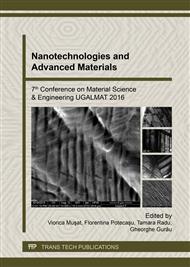p.13
p.20
p.26
p.32
p.38
p.45
p.52
p.58
p.64
Effect of Secondary Vacuum Treatment on Performance Characteristics of A516 Grade 65 Carbon Steel
Abstract:
The purpose of this research is to analyze the making technology of clean steel used in the oil, gas and petrochemical industry. The steel was obtained into conventional electric arc furnace. To enhance the steel quality a secondary refining treatment was applied. The purity characteristics of the steel A516 Grade 65, before and after the treatment in the vacuum arc degassing equipment are discussed and compared. The deoxidation, desulphurisation in the presence of basic slag and degassing by injecting an inert gas and also by vacuum exposure are effective in reducing non-metallic inclusions and for chemical composition control. Data from 31 melts obtained in two industrial conditions are presented according to steel making parameters. The variation of chemical composition, especially of content of S, P, and the cleanliness of the steel in terms of content of non-metallic inclusions are analyzed.
Info:
Periodical:
Pages:
38-44
Citation:
Online since:
February 2017
Authors:
Keywords:
Price:
Сopyright:
© 2017 Trans Tech Publications Ltd. All Rights Reserved
Share:
Citation:


